| Mission type | Communications |
|---|---|
| Operator | SBS |
| COSPAR ID | 1981-096A |
| SATCAT no. | 12855 |
| Mission duration | 7 years design life |
| Spacecraft properties | |
| Bus | HS-376 |
| Manufacturer | Hughes Space and Communications |
| Launch mass | 550 kilograms (1,210 lb) |
| Start of mission | |
| Launch date | 24 September 1981, 23:09 UTC |
| Rocket | Delta-3910 PAM-D |
| Launch site | Cape Canaveral LC-17A |
| Contractor | NASA |
| End of mission | |
| Disposal | Decommissioned |
| Deactivated | September 1996 |
| Orbital parameters | |
| Reference system | Geocentric |
| Regime | Geostationary |
| Longitude | 117° W [1] |
| Eccentricity | 0.73679 |
| Perigee | 166 kilometres (103 mi) |
| Apogee | 36,830 kilometres (22,890 mi) |
| Inclination | 27.7° |
| Period | 650.8 minutes |
| Epoch | September 24, 1981 |
| Transponders | |
| Band | 14 Ku band |
SBS 2 was a geostationary communications satellite designed and manufactured by Hughes (now Boeing) on the HS-376 platform. It was ordered by Satellite Business Systems, which later sold it to Hughes Communications. It had a Ku band payload and operated on the 117°W longitude. [2]

A geostationary orbit, often referred to as a geosynchronous equatorial orbit (GEO), is a circular geosynchronous orbit 35,786 km (22,236 mi) above Earth's equator and following the direction of Earth's rotation. An object in such an orbit appears motionless, at a fixed position in the sky, to ground observers. Communications satellites and weather satellites are often placed in geostationary orbits, so that the satellite antennae that communicate with them do not have to rotate to track them, but can be pointed permanently at the position in the sky where the satellites are located. Using this characteristic, ocean-color monitoring satellites with visible and near-infrared light sensors can also be operated in geostationary orbit in order to monitor sensitive changes of ocean environments.

A communications satellite is an artificial satellite that relays and amplifies radio telecommunications signals via a transponder; it creates a communication channel between a source transmitter and a receiver at different locations on Earth. Communications satellites are used for television, telephone, radio, internet, and military applications. There are 2,134 communications satellites in Earth’s orbit, used by both private and government organizations. Many are in geostationary orbit 22,200 miles (35,700 km) above the equator, so that the satellite appears stationary at the same point in the sky, so the satellite dish antennas of ground stations can be aimed permanently at that spot and do not have to move to track it.
The Boeing Satellite Development Center is a major business unit of Boeing Defense, Space & Security. It brought together Boeing satellite operations with that of GM Hughes Electronics' Space and Communications division in El Segundo, California.









